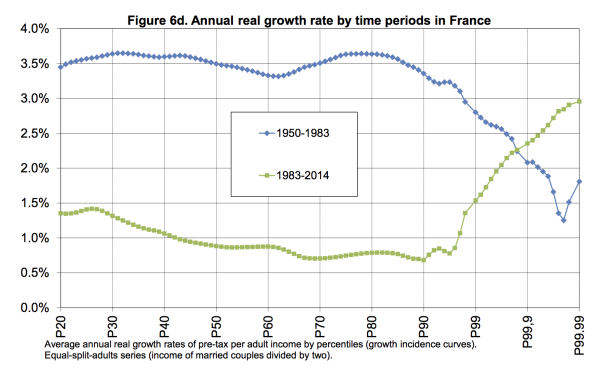From David Ruccio On the eve of their presidential election, the French people and politicians continue to debate how they should respond to the end of “Les Trente Glorieuses,” a period that appears to receding into ancient history. Except, as it turns out, for those at the very top, for whom the last thirty years have been quite glorious. According to new research by Bertrand Garbinti, Jonathan Goupille-Lebret, and Thomas Piketty, between 1983 and 2014, average per adult national income rose by 35 percent in real terms in France. However, actual cumulated growth was not the same for all income groups: the growth incidence curve is characterized by an impressive upward-sloping part at the top. Cumulated growth between 1983 and 2014 was 31% on average for the bottom 50% of the distribution, 27% for next 40%, and 50% for the top 10%. Most importantly, cumulated growth remains below average until the 95th percentile, and then rises steeply, up to as much as 100% for the top 1% and 150% for the top 0,01%. The contrast with the earlier, 1950-1983 period is particularly striking. In effect, during the “Thirty Glorious Years,” Garbinti, Goupille-Lebret, and Piketty observe the exact opposite pattern: growth rates were very high for the bottom 95 percent of the population (about 3.5 percent per year) and fell abruptly above the 95th percentile (1.5 percent at the very top).
Topics:
David F. Ruccio considers the following as important: Uncategorized
This could be interesting, too:
tom writes The Ukraine war and Europe’s deepening march of folly
Stavros Mavroudeas writes CfP of Marxist Macroeconomic Modelling workgroup – 18th WAPE Forum, Istanbul August 6-8, 2025
Lars Pålsson Syll writes The pretence-of-knowledge syndrome
Dean Baker writes Crypto and Donald Trump’s strategic baseball card reserve
from David Ruccio
On the eve of their presidential election, the French people and politicians continue to debate how they should respond to the end of “Les Trente Glorieuses,” a period that appears to receding into ancient history.
Except, as it turns out, for those at the very top, for whom the last thirty years have been quite glorious.
According to new research by Bertrand Garbinti, Jonathan Goupille-Lebret, and Thomas Piketty, between 1983 and 2014, average per adult national income rose by 35 percent in real terms in France. However, actual cumulated growth was not the same for all income groups:
the growth incidence curve is characterized by an impressive upward-sloping part at the top. Cumulated growth between 1983 and 2014 was 31% on average for the bottom 50% of the distribution, 27% for next 40%, and 50% for the top 10%. Most importantly, cumulated growth remains below average until the 95th percentile, and then rises steeply, up to as much as 100% for the top 1% and 150% for the top 0,01%.
The contrast with the earlier, 1950-1983 period is particularly striking. In effect, during the “Thirty Glorious Years,” Garbinti, Goupille-Lebret, and Piketty observe the exact opposite pattern: growth rates were very high for the bottom 95 percent of the population (about 3.5 percent per year) and fell abruptly above the 95th percentile (1.5 percent at the very top). However, as is clear from the chart above, between 1983 and 2014, growth rates were very modest for the bottom 95 percent of the population (about 1 percent per year) and rose sharply above the 95th percentile (3 percent at the very top).
As we know, similar patterns hold for the United Kingdom (which voted for Brexit) and the United States (which elected Donald Trump).
The key question in France, in the first and second rounds of the presidential election, is how French voters will respond to a political economy that has generated thirty glorious years only for those at the very top.

